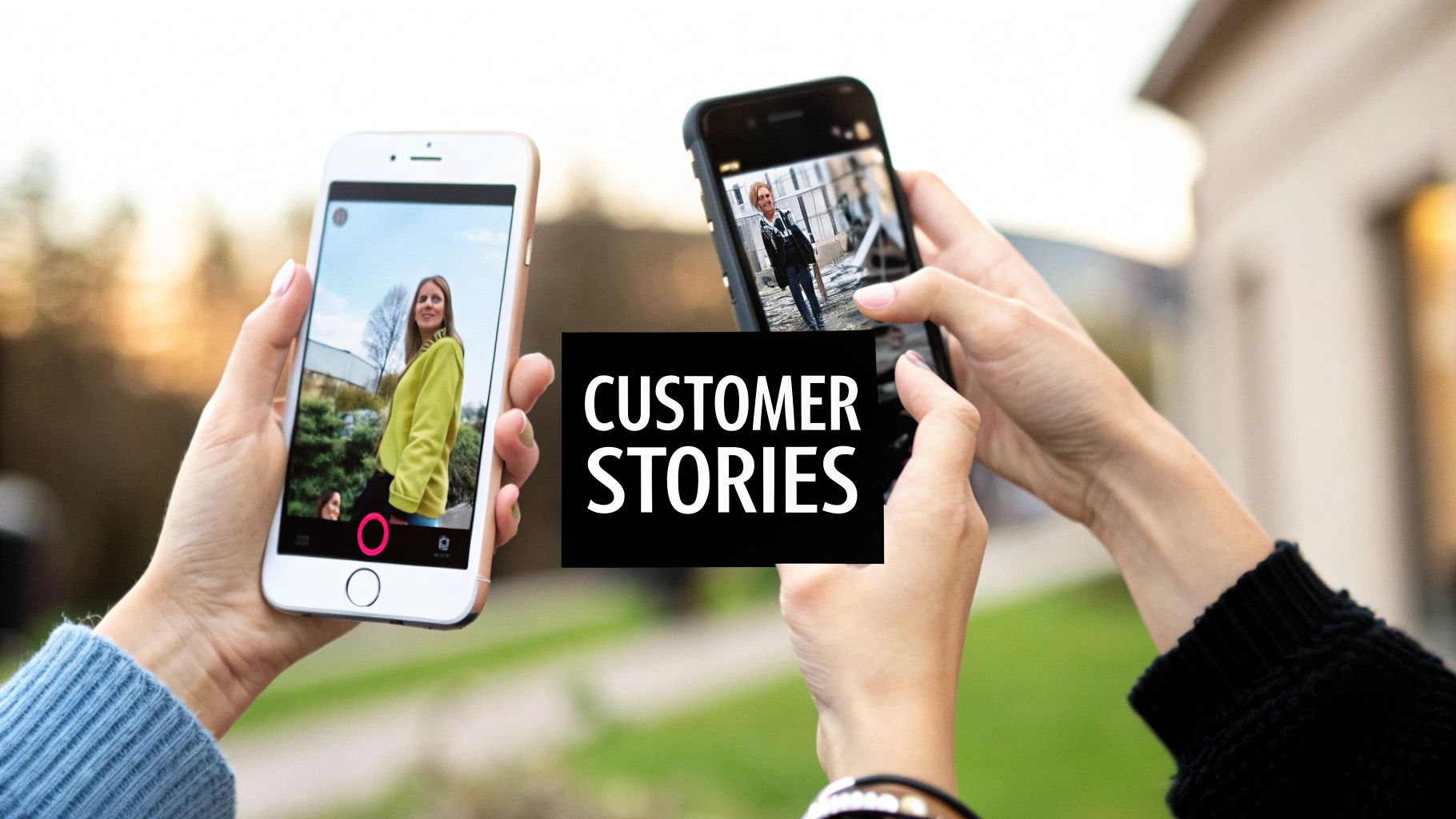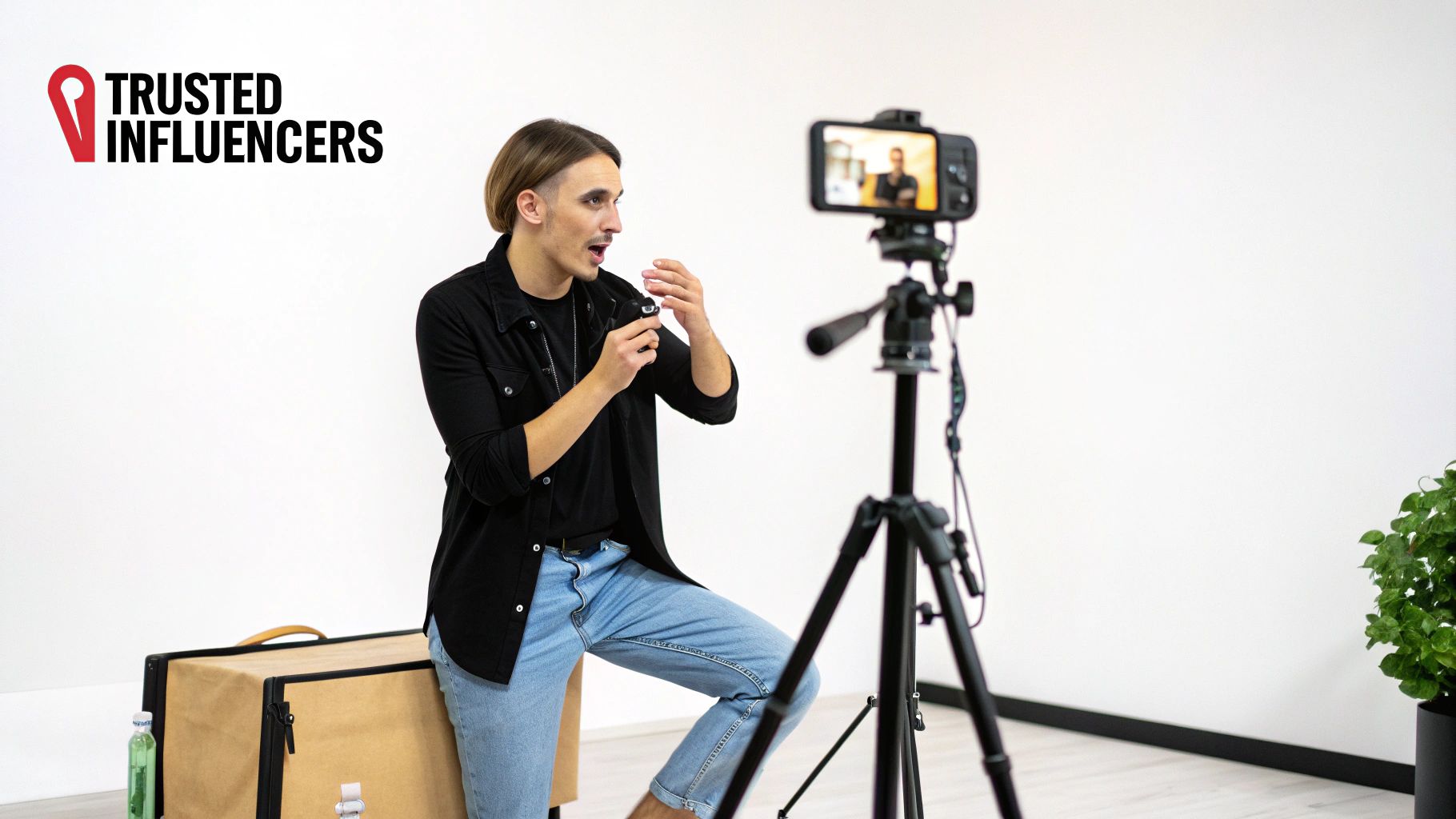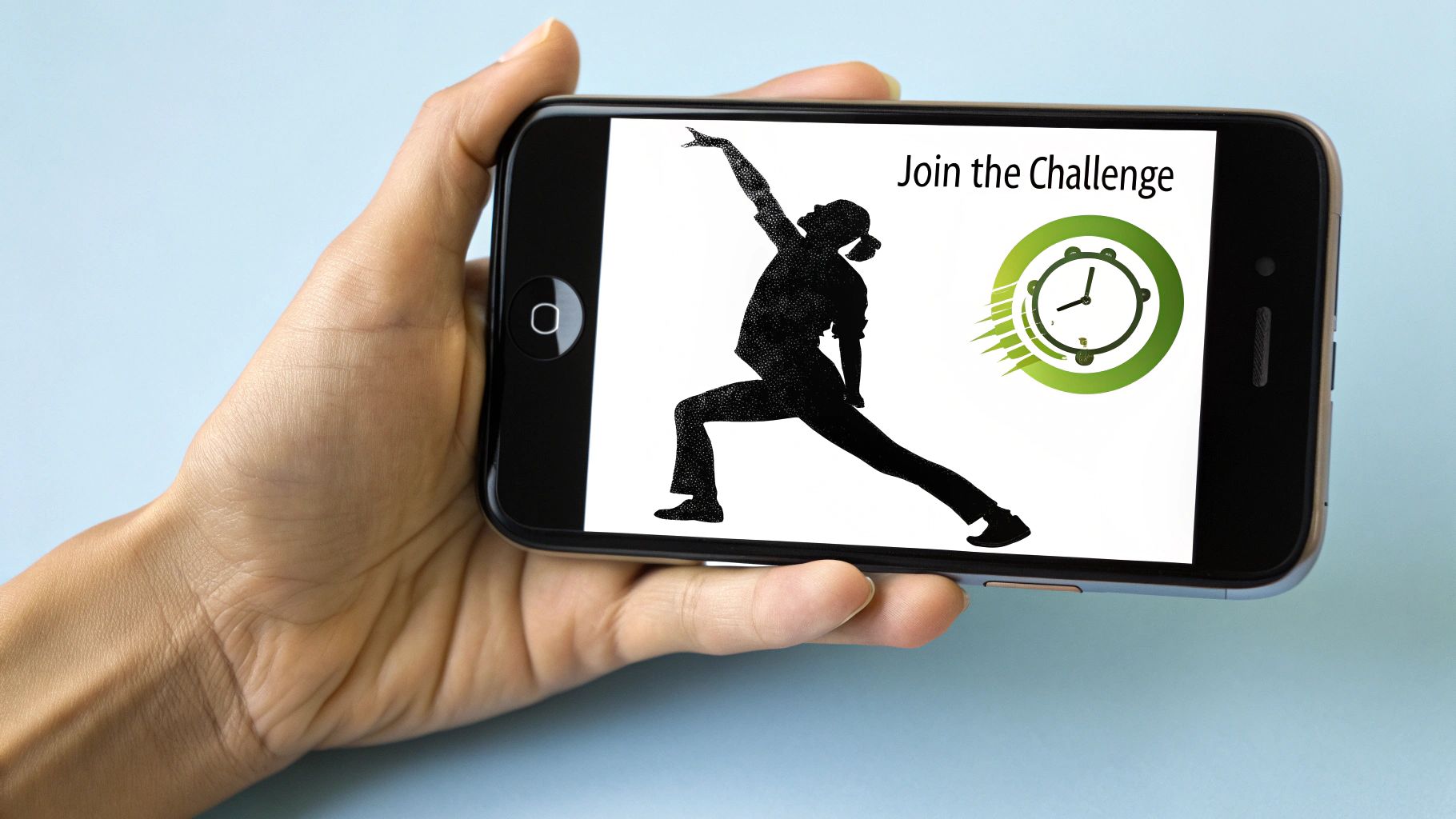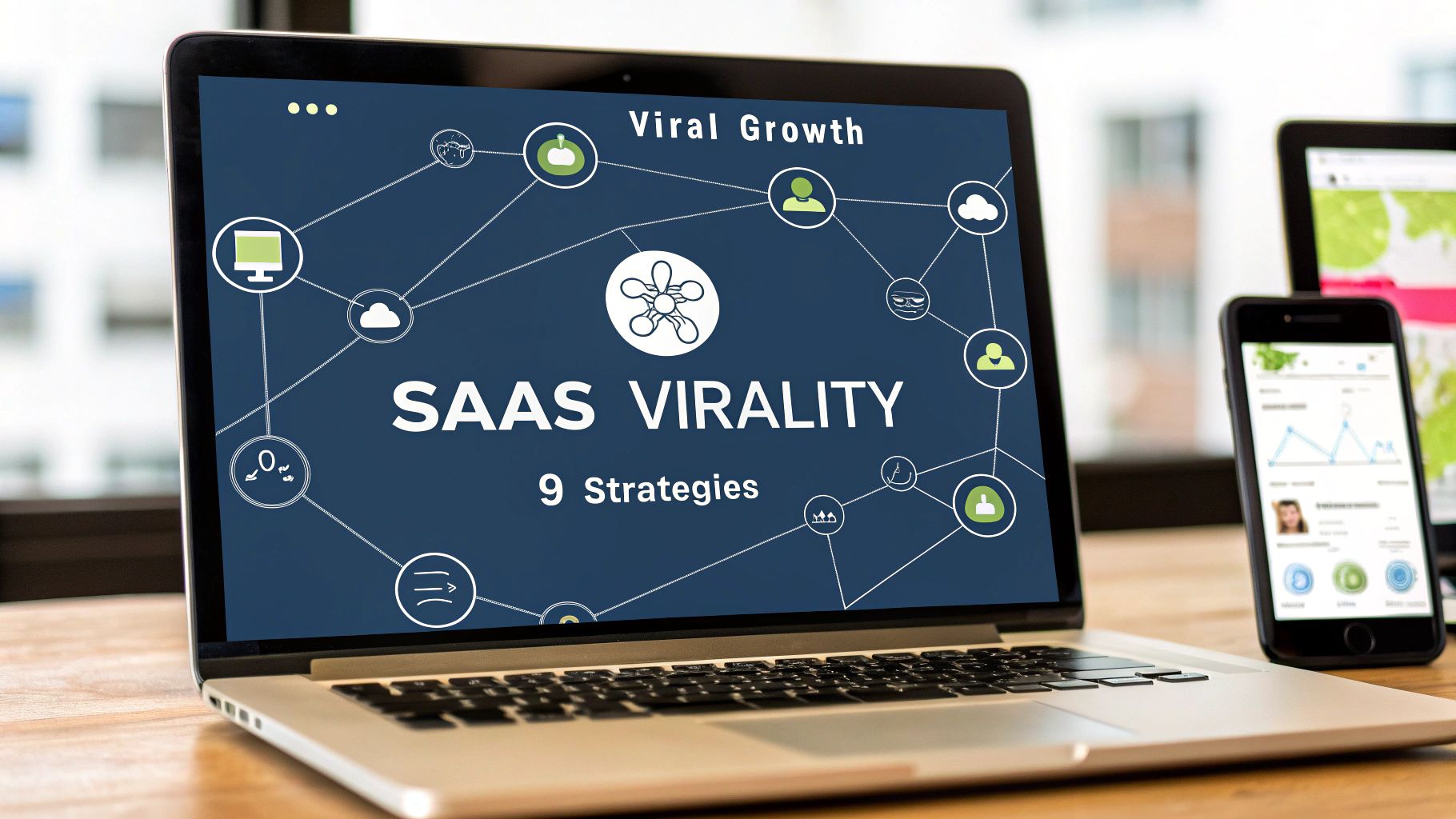Viral marketing isn't about luck or a single hit video; it's about engineering shareability directly into your product and marketing. For Software-as-a-Service (SaaS) companies, creating a powerful 'viral loop' where each new user organically brings in more users is the ultimate key to unlocking exponential, cost-effective growth. This isn't just about getting noticed, it's about building a sustainable acquisition engine. A cornerstone of engineering virality for SaaS involves understanding how to leverage specific tactics like using interactive video to drive SaaS customer engagement, making the user experience itself inherently shareable.
This article moves beyond generic advice to provide a tactical roundup of nine proven viral marketing strategies designed for software products. We will break down precisely how to implement each one, from user-generated content campaigns to surprise and delight initiatives that foster genuine advocacy. You'll find specific examples and actionable steps you can use immediately to amplify your reach, build a passionate user base, and turn your customers into your most powerful marketing channel. Forget chasing fleeting trends; get ready to learn the mechanics behind explosive, repeatable growth.
1. User-Generated Content (UGC) Campaigns
User-Generated Content (UGC) campaigns are among the most powerful viral marketing strategies because they transform customers into brand advocates. This approach involves encouraging your user base to create and share content, such as videos, photos, or reviews, that features your SaaS product. It leverages authentic, peer-to-peer endorsements, which build trust and credibility far more effectively than traditional advertising.

This strategy works by tapping into a basic human desire for recognition and community. When you feature a user's content, you validate their creativity and strengthen their connection to your brand. For a SaaS company, this could mean users sharing dashboards they created, video tutorials of them using a specific feature, or testimonials about how your software solved a major pain point. Think of GoPro's adventure videos or Airbnb's host-submitted property photos, both of which created massive, self-sustaining marketing engines.
How to Implement a UGC Campaign
- Define a Clear Goal and Hashtag: Start with a specific objective, like showcasing a new feature. Create a simple, memorable hashtag (e.g., #NotionMakeover) for users to tag their submissions on social media platforms.
- Offer Compelling Incentives: Motivate participation by offering valuable rewards. This could be a premium subscription upgrade, a feature on your homepage, exclusive merchandise, or a cash prize. The incentive should align with your users' interests.
- Promote and Showcase Submissions: Actively promote your campaign across all your channels, including email newsletters, social media, and within your app. Regularly feature the best UGC submissions on your official accounts to inspire more users to participate.
- Engage with Your Community: Respond to, like, and share submissions to foster a sense of community and appreciation. This engagement is crucial for maintaining momentum. For brands looking to scale their efforts, exploring the top UGC creator platforms can help connect you with experienced creators who can produce high-quality, authentic content.
2. Influencer Marketing
Influencer Marketing leverages individuals with established credibility and a dedicated social media following to promote your product. This strategy bypasses traditional advertising noise by capitalizing on the trust influencers have built with their audience. When an influencer recommends your SaaS, it’s perceived as a genuine endorsement from a trusted source, driving significant brand awareness and conversions.

This viral marketing strategy works because it taps into authenticity and niche expertise. Unlike a celebrity endorsement, an influencer within your industry, such as a prominent developer or a well-known project manager, can demonstrate how your software solves real-world problems. Think of how Daniel Wellington used micro-influencers to build a $200M brand or how Glossier partnered with beauty enthusiasts to create a cult following. The same principle applies to SaaS, where a respected figure can validate your product's value to a highly relevant audience.
How to Implement Influencer Marketing
- Identify the Right Influencers: Focus on relevance and engagement over sheer follower count. Look for influencers whose audience demographics and values align perfectly with your ideal customer profile.
- Grant Creative Freedom with Guardrails: Provide clear brand guidelines but allow the influencer creative freedom to produce content that feels authentic to their style. Their audience follows them for their unique voice, not for a scripted ad.
- Build Long-Term Partnerships: One-off campaigns can be effective, but long-term relationships foster deeper brand advocacy. This can often be structured similarly to a SaaS affiliate marketing program, providing ongoing incentives for continued promotion.
- Track Meaningful Metrics: Move beyond vanity metrics like likes. Track conversions, sign-ups, and demo requests using unique promo codes or referral links to measure the campaign's true ROI. To delve deeper into best practices for leveraging key opinion leaders, explore various Influencer Marketing strategies.
3. Social Media Challenges
Social media challenges are powerful viral marketing strategies that motivate users to perform a specific, shareable task and nominate others to do the same. This approach leverages network effects and social proof, as participation spreads exponentially through friend and follower networks. The core appeal lies in a shared experience, friendly competition, and the entertainment value of watching others participate.

This strategy works by creating a low-barrier-to-entry activity that is both fun to do and fun to watch. Think of the widespread engagement of the ALS Ice Bucket Challenge or the creative explosion from TikTok's #InMyFeelingsChallenge. For a SaaS company, a challenge could involve users creating a unique project with your software under a specific theme or demonstrating a "hidden" feature in a creative way. The goal is to make participation an engaging and easily replicable act that naturally promotes your product.
How to Implement a Social Media Challenge
- Keep it Simple and Safe: Design a challenge with clear, easy-to-follow instructions. The activity must be safe, inclusive, and appropriate for a broad audience to ensure it doesn't attract negative attention or alienate potential participants.
- Create a Branded Hashtag: A unique and memorable hashtag is essential for tracking submissions and unifying the campaign. Make it short, relevant, and easy to spell (e.g., #CanvaDesignChallenge).
- Seed the Challenge with Influencers: Kickstart the momentum by collaborating with a few key influencers or power users in your niche. Their initial participation provides the social proof needed to inspire their followers to join in.
- Amplify and Reward Participation: Actively monitor the hashtag and share the best, most creative, or funniest submissions across your official social media channels. Offer rewards like premium subscriptions, features in your newsletter, or company swag to incentivize high-quality content.
4. Emotional Storytelling
Emotional storytelling is one of the most resonant viral marketing strategies, focusing on creating a deep, human connection with your audience. Instead of highlighting product features, this approach weaves a compelling narrative designed to evoke strong feelings like joy, inspiration, or empathy. When a story touches someone's heart, they are far more likely to remember the brand behind it and share the experience with others.

This strategy works because humans are wired for stories and emotions drive our decisions and actions. A well-crafted narrative transcends traditional marketing by associating your brand with universal human values and experiences. Think of Google's annual "Year in Search" videos, which recap significant global moments, or Dove's "Real Beauty" campaign, which challenges narrow beauty standards. These campaigns went viral not because they sold a product, but because they told a story that people felt compelled to share and discuss. For a SaaS company, this could mean sharing a customer's success story in a way that highlights their struggle and eventual triumph, thanks to your tool.
How to Implement Emotional Storytelling
- Identify a Core Emotion and Value: Pinpoint a universal emotion that aligns with your brand's core values. Are you about empowerment, connection, or overcoming challenges? This will be the foundation of your narrative.
- Focus on the Human Element: Your story should center on people, not your software. Showcase a customer's journey, a founder's mission, or a community's achievement. Make the protagonist relatable to your target audience.
- Ensure Authenticity: The story must feel genuine and true to your brand. Audiences can spot inauthenticity quickly, which can damage trust. Be transparent and honest in your narrative approach. To dive deeper into crafting compelling narratives, you can find valuable insights on building a brand through emotional storytelling.
- Create for Sharability: Design the content, whether it's a video, blog post, or social media update, to be easily shared. Keep it concise, visually appealing, and end with a clear, emotionally resonant message that encourages sharing.
5. Interactive Content and Gamification
Interactive content and gamification are viral marketing strategies that transform passive consumption into active participation. This approach involves integrating game-like mechanics, quizzes, polls, or calculators directly into your marketing, making your brand experience more engaging and memorable. By requiring an action from the user, you create a deeper connection and generate content that is inherently more shareable.
This strategy capitalizes on the human desire for achievement, competition, and self-expression. Think of Spotify's annual "Wrapped" campaign, which turns a user's listening data into a personalized, highly shareable story. Similarly, BuzzFeed's personality quizzes went viral because they gave users a fun, simple way to learn something about themselves and share it with their network. For SaaS, this could be a calculator showing potential ROI or a quiz that helps users identify their biggest workflow challenge.
How to Implement Interactive Content and Gamification
- Keep Interactions Simple and Intuitive: The goal is to engage, not to frustrate. Ensure your quiz, poll, or game is easy to understand and use, especially on mobile devices. A complex interface will cause users to drop off before they can share.
- Provide Immediate and Valuable Feedback: Users expect instant gratification. Whether it's a quiz result, a calculator output, or a badge earned, deliver the results immediately. The value should be genuine, offering a real insight or a fun outcome.
- Design for Shareability: Make the results easy to share on social media with pre-populated text and eye-catching visuals. The shared content should be a badge of honor or a point of conversation, prompting others to participate.
- Integrate with Your Core Product: Connect the experience back to your SaaS tool. A gamified onboarding that awards badges for completing key actions can significantly improve user retention. This tactic can also be combined with other growth methods; for instance, some of the most effective referral marketing ideas incorporate gamified leaderboards to drive friendly competition among users.
6. Real-Time Marketing and Newsjacking
Real-Time Marketing and Newsjacking are viral marketing strategies that involve capitalizing on current events, breaking news, or trending topics to create timely and relevant content. This approach positions your brand at the center of a popular conversation, allowing you to ride the wave of an existing trend to gain massive, immediate visibility. It demands agility and a deep understanding of pop culture and online discourse.
This strategy works because it makes your brand feel current, human, and culturally aware. When executed well, it can generate enormous engagement as people are already focused on the topic. The classic example is Oreo's "You can still dunk in the dark" tweet during the Super Bowl blackout. For a SaaS company, this could mean creating a blog post titled "How Our Project Management Tool Can Help You Navigate [Major Industry Disruption]" or a witty social media post connecting a feature to a trending meme.
How to Implement Real-Time Marketing
- Monitor Trends Constantly: Use tools like Google Trends, Twitter's "Trending" section, and industry-specific news aggregators to stay ahead of what people are talking about. Speed is the most critical element for success.
- Ensure Brand Relevance: Don't force a connection. Your content must have a natural and logical link to the trending topic and your SaaS product's value proposition. A forced reference feels awkward and inauthentic.
- Act with Sensitivity and Authenticity: Carefully assess the tone of the event. Newsjacking tragedies or sensitive political issues can result in severe backlash. Always stay true to your brand's voice and values, whether it's humorous, helpful, or professional.
- Establish a Rapid Approval Process: Real-time opportunities disappear in hours, sometimes minutes. Create a streamlined approval process with key stakeholders so your team can create and deploy content quickly without getting bogged down in red tape.
7. Meme Marketing
Meme marketing leverages the internet's most shareable currency, humor and cultural references, to communicate brand messages. This strategy involves creating or adapting popular internet memes and viral formats to resonate with your audience, making your brand feel more human, relatable, and culturally aware. By tapping into existing trends, you can create content that is instantly recognizable and highly shareable.
This approach works because memes are a form of shared language online. When a SaaS brand uses a meme correctly, it signals that it understands its audience's culture and doesn't take itself too seriously. This can break down formal barriers and foster a more authentic connection. For instance, a project management tool might use a popular meme format to joke about disorganized workflows, making their solution feel like a knowing wink rather than a hard sell. Brands like Wendy's and Netflix have mastered this by integrating memes seamlessly into their social media, creating viral moments that boost engagement and brand personality.
How to Implement Meme Marketing
- Understand Your Audience's Meme Fluency: Before you start, gauge your audience's familiarity with internet culture. A meme that resonates with Gen Z might fall flat with an older, more corporate demographic. Analyze the type of humor and formats they engage with on platforms like X (formerly Twitter), Reddit, or LinkedIn.
- Stay Current but Act Fast: Meme formats have a notoriously short lifespan. What's hilarious today can be cringe-worthy next week. Use resources like "Know Your Meme" or simply spend time on relevant social platforms to stay updated, but be prepared to create and post content quickly to capitalize on a trend.
- Maintain an Authentic Brand Voice: Your memes should sound like they're coming from your brand, not like you're awkwardly trying to fit in. Don't force a meme if it doesn't align with your brand's personality. Authenticity is key; users can spot a forced attempt from a mile away.
- Align Memes with Product Value: The most effective meme marketing strategies connect the humor back to the product's value proposition, even subtly. The goal is not just to get a laugh but to make your brand memorable in a relevant context. For example, a cybersecurity SaaS could use a meme about weak passwords to reinforce the need for their tool.
8. Controversy and Provocative Marketing
Controversy and Provocative Marketing is a high-risk, high-reward strategy that deliberately uses bold or polarizing content to spark intense discussion and media attention. This approach cuts through the noise by tapping into sensitive cultural, social, or political topics, forcing audiences to form and share strong opinions. When executed carefully, it can catapult a brand into the public consciousness overnight.
This tactic works because it elicits powerful emotional responses, making the content highly shareable. For a SaaS company, this is less about the product itself and more about the brand's core values and what it stands for. Think of Patagonia’s environmental activism or Nike’s campaign with Colin Kaepernick; both ignited global conversations that transcended their products and cemented their brand identities with specific audiences. It’s one of the most potent viral marketing strategies for brands brave enough to take a stand.
How to Implement Provocative Marketing
- Align with Core Brand Values: The controversy must be authentic and rooted in your company's genuine mission. A sudden, unsupported political statement will be seen as opportunistic. Your stance should feel like a natural extension of who you are as a brand.
- Understand Your Audience Deeply: Know where your ideal customers stand on the issue. This strategy is designed to attract your tribe while likely alienating others. Ensure you are connecting with the audience that matters most to your long-term success.
- Prepare for Backlash: Have a comprehensive crisis management plan ready before you launch. This should include pre-approved statements, social media response protocols, and designated spokespeople. Anticipate both positive and negative reactions and be ready to manage both.
- Stand Firm on Your Message: Once you take a stand, do not back down. Waffling or apologizing for your stance will destroy your credibility with both supporters and detractors. The goal is to show conviction, which builds deep loyalty among those who agree with you.
9. Surprise and Delight Campaigns
Surprise and Delight is a powerful viral marketing strategy that revolves around creating unexpected, positive experiences for customers. Instead of a direct sales pitch, this approach focuses on generating genuine happiness and emotional connection. These memorable moments foster deep brand loyalty and inspire customers to share their positive experiences organically through word-of-mouth and on social media, creating authentic buzz.
This strategy works because it subverts expectations and taps into the psychology of reciprocity and delight. When a brand goes above and beyond without being asked, it feels personal and special. For a SaaS company, this could be anything from a surprise upgrade to a premium plan for a loyal user, a handwritten thank-you note, or a small, thoughtful gift sent to a long-time customer. Think of Chewy sending personalized pet portraits to customers or Zappos' legendary surprise overnight shipping upgrades.
How to Implement a Surprise and Delight Campaign
- Identify Opportunities for Delight: Monitor customer support interactions, social media mentions, and usage data to find high-value customers or those who could use a positive boost. A user celebrating a business anniversary or a long-time subscriber are perfect candidates.
- Focus on Genuinely Meaningful Gestures: The surprise shouldn't feel like a calculated marketing tactic. It should be authentic and align with your brand values. A personalized video message from the founder can be more impactful than a generic discount code.
- Empower Your Team: Give your customer-facing teams the autonomy and budget to create these moments. Train them to spot opportunities and act on them without needing layers of approval. This ensures the experience feels spontaneous and sincere.
- Document and Share Strategically: While the primary goal is the individual's delight, you can amplify the impact. Ask for permission to share the customer's story or reaction on your blog or social channels. This showcases your company culture and encourages more positive sentiment.
Viral Marketing Strategies: 9-Point Comparison
| Marketing Strategy | Implementation Complexity 🔄 | Resource Requirements ⚡ | Expected Outcomes 📊 | Ideal Use Cases 💡 | Key Advantages ⭐ |
|---|---|---|---|---|---|
| User-Generated Content (UGC) Campaigns | Medium - needs community management | Low to Medium - incentives & monitoring | Moderate - increased brand trust & awareness | Brands seeking authentic engagement and organic reach | High authenticity, cost-effective, social proof |
| Influencer Marketing | Medium to High - influencer coordination | Medium to High - influencer payments | High - targeted audience reach & conversions | Targeted demographics, niche markets, scalable campaigns | Trusted endorsements, niche market access |
| Social Media Challenges | Low to Medium - creative seeding & monitoring | Low - mostly social platforms | High - viral potential and user engagement | Viral awareness, quick engagement boosts | Explosive virality, low cost, strong participation |
| Emotional Storytelling | High - requires quality content production | High - production of emotional content | High - strong emotional connections & loyalty | Brands wanting deep emotional resonance and differentiation | Memorable, shareable, brand affinity |
| Interactive Content & Gamification | High - tech development & maintenance | High - development, updates | High - increased engagement & personalized data | Engagement-driven campaigns, data collection, retention | High engagement, personalized experience |
| Real-Time Marketing & Newsjacking | High - rapid content creation & approval | Medium - team for monitoring & creation | Medium - timely visibility & potential virality | Brands able to respond fast to trends and events | Cost-effective, agile, potential viral boost |
| Meme Marketing | Low - conceptually simple but requires cultural fluency | Low - creative content | Medium - high shareability in younger demographics | Brands targeting youth with humorous, relatable content | Low cost, highly shareable, brand personality |
| Controversy & Provocative Marketing | High - careful planning & risk management | Medium - campaign management | Variable - high attention but risky impact | Brands willing to take bold stands and handle backlash | Strong buzz, clear differentiation |
| Surprise and Delight Campaigns | Medium to High - planning & execution | Medium to High - experiential costs | Medium - positive emotions & organic sharing | Customer loyalty building through memorable experiences | Strong emotional impact, word-of-mouth growth |
Putting Virality into Practice: Your Next Move
We've explored a powerful arsenal of viral marketing strategies, from harnessing the authenticity of User-Generated Content to the instant buzz of a well-timed Meme Marketing campaign. You've seen how emotional storytelling can forge deep connections, how interactive content can turn passive viewers into active participants, and how a dash of controversy can capture widespread attention. Each of these tactics holds the potential to transform your SaaS product from a useful tool into a cultural touchstone.
However, the most crucial takeaway is that virality isn't born from a single lucky break or one-off campaign. It is the result of a deliberate, systematic approach. True viral growth happens when sharing is not an afterthought but is woven into the very fabric of your product and user experience. It's about creating a self-perpetuating loop where users are naturally incentivized and empowered to become your most effective marketers.
From Strategy to System: Building Your Viral Engine
The most successful SaaS companies understand this principle. They don't just run a social media challenge; they build gamified leaderboards into their platform. They don't just hope for influencer mentions; they create affiliate programs that reward creators for driving real sign-ups. They masterfully combine several of the strategies we've discussed into a cohesive, measurable, and scalable system.
Your goal is to move from isolated tactics to an integrated growth engine. This system should make sharing feel like a natural, valuable part of using your product.
Key Insight: The ultimate goal is not just to "go viral" once. It's to build a sustainable system where every new user has the potential to bring in the next one, creating exponential growth fueled by genuine advocacy.
Your Actionable Next Steps
Feeling overwhelmed? Don't be. The journey to building a viral loop starts with a single, well-chosen step. Here’s how you can begin putting these viral marketing strategies into practice today:
- Select Your Starting Point: Review the nine strategies and pick one that best aligns with your brand voice, product features, and target audience. If your platform is highly visual, a UGC campaign might be perfect. If your user base is competitive, gamification could be a home run.
- Define and Implement: Create a small, manageable pilot project for your chosen strategy. Define what success looks like with clear metrics. For example, are you tracking shares, referral sign-ups, or brand mentions?
- Measure and Learn: Launch your campaign and meticulously track the results. Don't be discouraged if it doesn't explode overnight. Analyze the data to understand what worked and what didn't.
- Iterate and Integrate: Use your learnings to refine your approach. Once you find a winning formula, focus on integrating it more deeply into your product to make it a permanent, automated part of your growth model.
By mastering these concepts, you are not just chasing trends; you are building a foundational asset for your business. You are creating a brand that people don't just use, but one they are excited to talk about and share with their networks. That is the sustainable power of truly effective viral marketing.
Ready to build a viral loop directly into your SaaS product? Refgrow allows you to launch a native, in-app referral program with just one line of code, turning your user base into a powerful growth engine. Stop dreaming about virality and start building it today with Refgrow.

